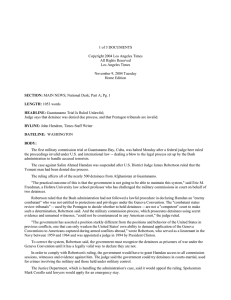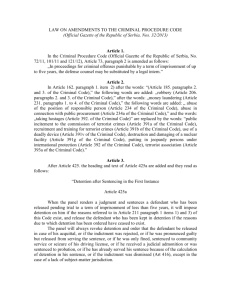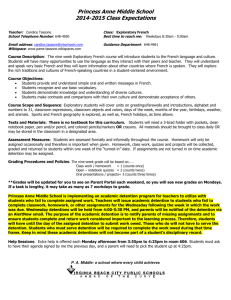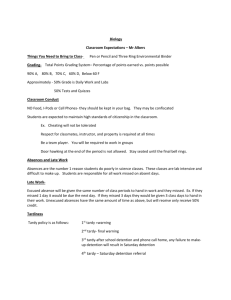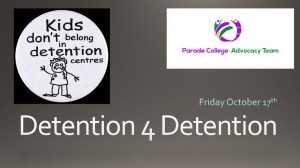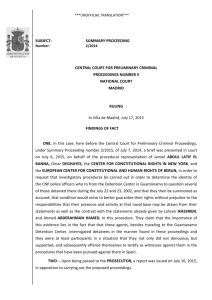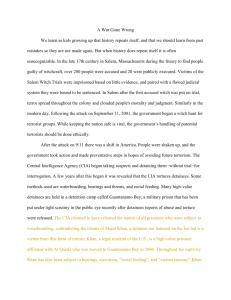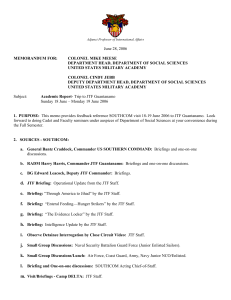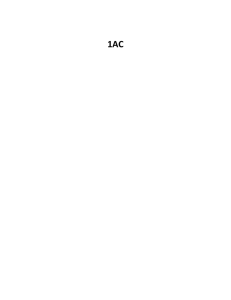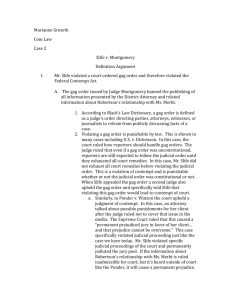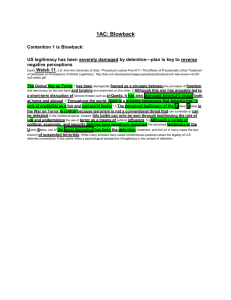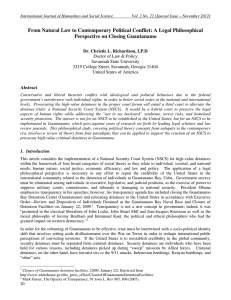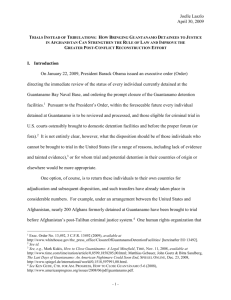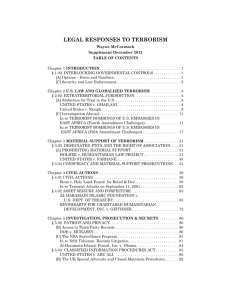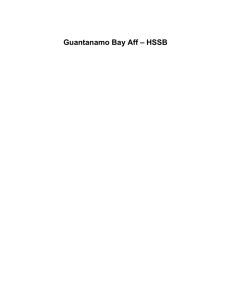Notes and Questions for first assignment from Guantanamo Diary
advertisement
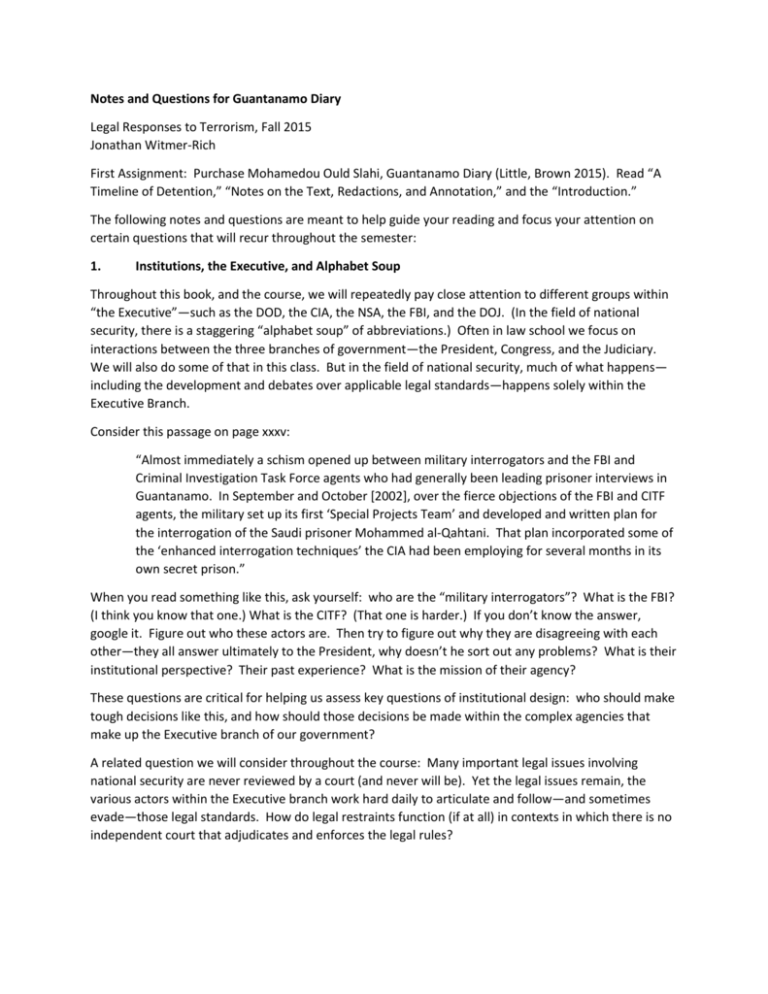
Notes and Questions for Guantanamo Diary Legal Responses to Terrorism, Fall 2015 Jonathan Witmer-Rich First Assignment: Purchase Mohamedou Ould Slahi, Guantanamo Diary (Little, Brown 2015). Read “A Timeline of Detention,” “Notes on the Text, Redactions, and Annotation,” and the “Introduction.” The following notes and questions are meant to help guide your reading and focus your attention on certain questions that will recur throughout the semester: 1. Institutions, the Executive, and Alphabet Soup Throughout this book, and the course, we will repeatedly pay close attention to different groups within “the Executive”—such as the DOD, the CIA, the NSA, the FBI, and the DOJ. (In the field of national security, there is a staggering “alphabet soup” of abbreviations.) Often in law school we focus on interactions between the three branches of government—the President, Congress, and the Judiciary. We will also do some of that in this class. But in the field of national security, much of what happens— including the development and debates over applicable legal standards—happens solely within the Executive Branch. Consider this passage on page xxxv: “Almost immediately a schism opened up between military interrogators and the FBI and Criminal Investigation Task Force agents who had generally been leading prisoner interviews in Guantanamo. In September and October [2002], over the fierce objections of the FBI and CITF agents, the military set up its first ‘Special Projects Team’ and developed and written plan for the interrogation of the Saudi prisoner Mohammed al-Qahtani. That plan incorporated some of the ‘enhanced interrogation techniques’ the CIA had been employing for several months in its own secret prison.” When you read something like this, ask yourself: who are the “military interrogators”? What is the FBI? (I think you know that one.) What is the CITF? (That one is harder.) If you don’t know the answer, google it. Figure out who these actors are. Then try to figure out why they are disagreeing with each other—they all answer ultimately to the President, why doesn’t he sort out any problems? What is their institutional perspective? Their past experience? What is the mission of their agency? These questions are critical for helping us assess key questions of institutional design: who should make tough decisions like this, and how should those decisions be made within the complex agencies that make up the Executive branch of our government? A related question we will consider throughout the course: Many important legal issues involving national security are never reviewed by a court (and never will be). Yet the legal issues remain, the various actors within the Executive branch work hard daily to articulate and follow—and sometimes evade—those legal standards. How do legal restraints function (if at all) in contexts in which there is no independent court that adjudicates and enforces the legal rules? 2. Rhetoric in the War on Terror On page xxxi (Introduction), Larry Siems quotes an editorial by the New York Daily News objecting to Judge Robertson’s grant of the writ of habeas corpus to Slahi. Specifically, the Daily News editorial describes Slahi as “possibly being a man whose guilt was certain but unprovable beyond a reasonable doubt thanks to squeamishness over evidence acquired under rough treatment.” What does this statement mean? Are there any legitimate concerns conveyed in that statement? The editorial next states: “What was the rush to release? The judge could have waited, should have waited, for the country to understand why this had to happen before exercising his legal authority.” Does Judge Robertson’s order represent a “rush to release”? And what does the second sentence above mean? (By the way, what does the phrase the “war on terror” mean?) 3. Different Legal Responses to Terrorism The introduction describes the complex legal history surrounding Slahi’s detention (a history that is not yet concluded). Part of what makes his case—and others like it—so hard to understand is the many different legal systems that apply or could apply to his case. Here is a brief explanation of some of the key legal systems/concepts at play: a. Article III Criminal Prosecution: often an act (or planned act) of terrorism violates particular criminal statutes. If so, the President (through the DOJ) can respond to terrorism by filing criminal charges in a U.S. federal court, and seek a conviction and sentence for suspected terrorists. In the counter-terrorism context we often refer to this as an “Article III” prosecution, referring to Article III of the Constitution—which establishes the judicial branch. This refers to a criminal prosecution in a regular federal court (with a judge appointed under Article III), rather than some other option such as a military commission. As you will see, criminal charges have never been filed against Slahi. Start thinking about why not. b. Military Commission: another option is to try to prosecute suspected terrorists in a military commission. We will study this option at greater length. For now, note that military commissions have a long history, but can be invoked only in particular circumstances. Military commission prosecutions are limited to prosecutions that meet all of the following conditions: (1) the act occurred during an armed conflict; (2) the act occurred in the theater of combat; (3) the defendant is a combatant in the armed conflict; and (4) the act is a war crime (a crime triable by military commission). The introduction notes that the government considered filing charges against Slahi in a military commission, but (so far) has not done so. Start thinking about why not. c. Preventive Military Detention: during an armed conflict, the parties to the conflict have (under long-standing international law) the power to capture and detain enemy soldiers. Thus during World War II the United States captured and detailed German soldiers, and vice versa. This is preventive military detention. The purpose is not to punish a captured combatant, but simply to prevent that soldier from returning to the battlefield. Generally speaking, a state can detain a combatant captured during an armed conflict, and may detain that captive until the end of hostilities (at which point the soldier must be released). This is the legal justification used by the Bush Administration and the Obama Administration for detaining Slahi (and the other Guantanamo Bay detainees). Many detainees (including Slahi) filed a petition for a writ of habeas corpus in federal court in D.C., challenging the legality of their detention. The government responded by arguing that the detention is lawful as a form of preventive military detention. Judge Robertson (who is discussed in the introduction) was the judge assigned to Slahi’s case. (Incidentally, Judge Robertson is the father-in-law of Professor Heidi Gorovitz Robertson.) Thus when Judge Robertson granted Slahi’s habeas petition, he determined that the government had failed to prove that Slahi was in fact a combatant in an armed conflict. These three legal regimes are in a sense separate, independent, and non-exclusive. That is to say, it may be true for a given detainee that all three of these options could be pursued, or only one or two of them, or none of them. The fact that criminal charges could be filed does not mean military commission charges cannot be filed; the fact that military commission charges could be filed does not mean that criminal charges cannot; the fact that a person is subject to preventive military detention does not mean he can be prosecuted in either an Article III criminal court or a military commission. To make sense of what is happening (legally) with Slahi or other detainees, you must first understand these three systems. Often in discussions and debates over detainees, commentators shift from one of these systems to the other and back again, often without admitting (or realizing) they are doing so, and often without even a basic understanding of the strengths and limitations of each system. One major goal in the course is for you to gain a good understanding of these three different systems: their powers and limitations, strengths and weaknesses. With that understanding, you can form more informed and substantial opinions on which of these tools (if any) should be used in response to terrorism, and when.
